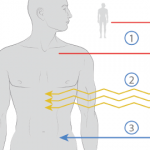 Rheumatologists treat more than 100 autoimmune diseases, and most agree that scleroderma is the worst. It disfigures patients and, in doing so, restricts bodily functions and social interactions. It also kills.
Rheumatologists treat more than 100 autoimmune diseases, and most agree that scleroderma is the worst. It disfigures patients and, in doing so, restricts bodily functions and social interactions. It also kills.
In January, Keith M. Sullivan, MD, professor of medicine at Duke University Medical Center in Durham, N.C., and colleagues reported in the New England Journal of Medicine that myeloablative autologous hematopoietic stem cell transplantation resulted in long-term benefits for patients with severe scleroderma.1
Patients in the trial, Scleroderma: Cyclophosphamide or Transplantation (SCOT), experienced improved event-free and overall survival. The study randomized patients to receive either stem cell therapy or cyclophosphamide treatment, and demonstrated that patients in the stem cell therapy group had increased cytopenias, but significantly better six-year survival after transplant (86% vs. 51%). The rates of treatment-related death and post-transplantation use of disease-modifying anti-rheumatic drugs (DMARDs) were lower than previous studies of nonmyeloablative transplantation.
Inform Patients of the Treatment Option
Dr. Sullivan spoke with The Rheumatologist about the results of the SCOT trial and urged rheumatologists to refer patients with scleroderma and internal organ involvement to a transplant center for consultation. Scleroderma is a rare disease, and diagnosis may be difficult or delayed. “Without an early referral, patients really won’t understand the details of the procedure, the risks and the gains,” he explains.
Patients whose scleroderma is limited to their skin typically do not experience an increase in mortality. However, one-third of the roughly 300,000 patients with scleroderma in the U.S. experience internal organ involvement, primarily of the lungs, kidneys and/or heart. These patients often progress to organ failure and death. Dr. Sullivan and colleagues are particularly interested in this subset of patients and think the benefits of stem cell treatment outweigh its risks for these patients. Dr. Sullivan suggests rheumatologists identify these patients early in disease via serial pulmonary function testing and CT chest imaging.
A Six-Year Study
The SCOT trial enrolled patients with severe scleroderma who had severe internal organ disease (as opposed to solely skin disease) and treated them with myeloablative therapy followed by CD34+ selected autologous hematopoietic stem cell transplantation. The publication of this research joins two other positive studies, one published in Lancet and the other published in JAMA, that tested nonmyeloablative transplant vs. cyclophosphamide.2,3
“This [research] has been a long-term investment for all my colleagues and NIH,” explains Dr. Sullivan. He emphasizes that the SCOT trial followed all participants for six years, during which the NIH award paid for patients to travel frequently back to their transplant center for assessments, monthly for a year then quarterly through Year 5. The trial demonstrated the durability of the beneficial effects of the stem cell treatment.
Complications from autologous transplantation for autoimmune disease can include treatment-related deaths, cancers and infections. The SCOT trial had a transplant-related mortality rate of 3% at 54 months and 6% at 72 months after randomization.
Future for Stem Cell Therapy & Scleroderma
Dr. Sullivan’s colleagues have some insights into the mechanism behind the therapy’s success. Shervin Assassi, MD, MS, of the University of Texas, Houston, will present the results of the SCOT trial at the upcoming Systemic Sclerosis World Congress in France. Early findings suggest that by 24 months after randomization, the genomic molecular signatures of scleroderma are normalized in the patients who received a transplant, but not in patients treated with cyclophosphamide. These data suggest stem cell therapy has the potential to renormalize the autoreactive immune system.
The U.S. has more than 200 hematopoietic stem cell transplant centers, seven of which participated in the SCOT trial. The investigators from the SCOT trial are reaching out to other centers to share techniques and protocols. In this way, transplant physicians are striving to make the stem cell treatment available to all patients suffering from scleroderma with internal organ involvement.
Dr. Sullivan also anticipates the future of stem cell therapy for patients with scleroderma. “I think our next step could be broadening the entry criteria,” he explains. Consideration is being given to including individuals with high risk, rapid and progressive-onset, skin only involvement, who were not included in the SCOT trial. From his discussions with patients, Dr. Sullivan believes that these individuals would also welcome the option of stem cell therapy.
“Physicians sometimes think they know what patients will accept in terms of risk, but may sometimes be mistaken,” he muses. Scleroderma can be debilitating and deadly and many patients would embrace an effective new treatment option.
Lara C. Pullen, PhD, is a medical writer based in the Chicago area.
References
- Sullivan KM, Goldmuntz EA, Keyes-Elstein L, et al. Myeloablative autologous stem-cell transplantation for severe scleroderma. N Engl J Med. 2018 Jan 4;378(1):35–47.
- Burt RK, Shah SJ, Dill K, et al. Autologous non-myeloablative haemopoietic stem-cell transplantation compared with pulse cyclophosphamide once per month for systemic sclerosis (ASSIST): an open-label, randomized Phase 2 trial. Lancet. 2011 Aug 6;378(9790):498–506. doi: 10.1016/S0140-6736(11)60982-3. Epub 2011 Jul 21.
- van Laar JM, Farge D, Sont JK, et al. Autologous hematopoietic stem cell transplantation vs intravenous pulse cyclophosphamide in diffuse cutaneous systemic sclerosis: A randomized clinical trial. JAMA. 2014 Jun 25;311(24):2490–2498. doi: 10.1001/jama.2014.6368.


